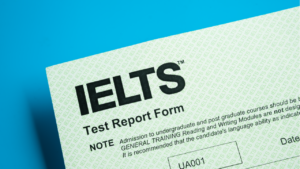You will encounter 40 questions in the Reading test. The passages in this test are taken from everyday things like guidelines, brochures, newspapers, and company handbooks. You can find a detailed description of the IELTS Reading Test in the table below.
IELTS Reading Test Overview
| Total Duration | 60 minutes |
| Number of sections | 3 |
| Number of questions | 40 |
| Marking | Each correct answer receives one mark |
| Band Score Range | 0-9 |
The passages in the test contain various question types, such as Multiple Choice Questions, Table Completion, Short Answer Questions and Sentence Completion.
Who Would Benefit from This Test:
This test suits people starting a job or moving to a new country. It assesses how quickly you can read and understand practical information, follow written directions, and pay attention to details in everyday situations.
Practice Recommendation:
To improve your reading, language, and vocabulary skills for the IELTS test, try practising with the “The Power of Play” reading answers. This blog provides the complete passage, different question types, and answers for the mentioned reading passage.
Explore More IELTS Reading Question Types:
Check out the blog for additional IELTS reading question types, such as sentence completion, table completion, and short answer questions. This resource will assist you in developing your reading skills as a student.
Leap Advantage Virtual Spot Offer Event on May 10th 2024

Last call to secure your spot for Masters in STEM Program in the US for Fall ’24 exclusively for graduates and above.
Leap Advantage Virtual Spot Offer Event on May 10th 2024
Last call to secure your spot for Masters in STEM Program in the US for Fall ’24 exclusively for graduates and above.

About the passage: The Power of Play
Let us explore why understanding and practising the reading passage on The Power of Play matters.
- This reading passage is part of the IELTS reading test. It is designed to check your ability to focus, manage time, read quickly, and grasp what you read.
- They included this passage to evaluate how effectively you handle information and apply what you know.
- Practising with this passage is beneficial because it helps you get familiar with different question types and improves your ability to choose the correct answers.
- Engaging in this exercise is valuable because it highlights areas where you excel and areas where you can improve.
If you want answers about The Power of Play reading passage, you have come to the right blog. The answers with explanations offer a clear understanding of your preparation progress.
Sample Passage
Let’s delve into the reading passage of The Power of Play.
The Power of Play
A. Almost every child in the world enjoys playing. Children are very driven towards playing that they can play in any state of affairs, like when they don’t have real toys or when active encouragement is not given by parents. For children, the pastime is running, dissembling and building. Researchers and educators perceive that children’s communal, intellectual, physical, and behavioral development all benefit from partaking in these kinds of extracurricular facilities. Undeniably, playtime holds a crucial role in the growth of a healthy child. Playing was recognized as a fundamental right by the United Nations High Commission on Human Rights in 1989.
B. Although experts continue to make a rational argument for the noteworthiness of play in children’s lives, there is a decline in the actual time children spend playing. Playing time has decreased by eight hours a week compared to two decades ago (Elkind 2008). Test preparation has displaced play in elementary and middle schools due to an increase in academic demands, and flashcards and educational ‘toys’ are marketed to parents who really want to give their toddlers forewarning. A deceitful paradox between play and learning is created by our society.
C. This resulted in their early experiences with play, children developing a wide range of abilities, including self-control, social concession, problem-solving, and a wide pasture of scientific and mathematical knowledge that will serve them throughout their lives. Adults also play a vital role in helping children learn via play.
D. Researchers and theorists who study play still can’t really agree on a formal definition of what it is. Definitions ambit from specific descriptions of distinct types of play, such as physical, construction, language, or symbolic play (Miller & Almon, 2009), to these broad characteristics that are designed to capture the core of all play behaviour based on analysis and attitudes (e.g. Rubin et al. 1983).
E. Most concepts of play concentrate on some key characteristics. Play is rendered as ‘something done only for the thrill of doing it’ by Stuart Brown, the founder of the National Institute of play. To be more precise, he says that, it ‘appears desultory, generates pressure and joy, [and] reaching the next level of mastery’ (as quoted in Tippett 2008). In the same way, in 2009 Miller and Almond said that play incorporates ‘Initiatives that are freely selected and directed by children and emerge from intrinsic desire’. Generally, this array of behavioural and dispositional parameters is used to describe play-along perpetuity as being more or less playful (e.g. Rubin et al. 1983).
F. Play is gratifying: Activity must be enjoyed by children or it’s not a play. It is substantially motivated: A child’s play is prompted only by the pleasure it provides. It has no extrinsically motivated purpose or ambition. Play is process-lucid: When children play, the meaning is more crucial than the ending. It is candidly chosen, impromptu and voluntary. If a child is under pressure, they will not anticipate play as an activity. If a child is under oppression, they will not anticipate play as an activity. Play is actively engrossed: Physical and/or mental engagement is a prerequisite for players in the activity. Play is metaphoric. It consolidates make-believe.
G. Children’s playful behaviour can range from 0% to 100% playful, according to this perspective. In determining playfulness Rubin and colleagues did not assign greater weight to any one dimension; however, it had been suggested by other researchers that process orientation and lack of evident functional purpose may be the most crucial features of play (e.g Pellegrini 2009).
H. Play, from the perspective of a continuum, might be combined with less frivolous motives and attitudes, such as work. Work, unlike pleasure, is usually not considered joyful and is extrinsically motivated(i.e. it is goal-oriented). According to Researcher Joan Goodman (1994), hybrid forms of work and play are not detrimental to learning; rather, they can provide optimal learning environments. For example, a child may be actively engaged and intrinsically motivated while participating in a tough, goal-directed exercise set up by their teacher. The child’s motivation, together with adult guidance, can generate robust chances for joyful learning at this midpoint between play and work.
I. A recent study suggests that adults may help children’s learning while keeping a lighthearted approach in interactions known as ‘guided play’ (Fisher et al. 2011) which is considered to be significant. The adult’s role in play varies as a function depending on their educational goals and the developmental level of the child (Hirsch-Pasek et al. 2009). There are two types of guided play. Adults can enrich a child’s environment at a very basic level by offering things or experiences that encourage components of a curriculum. Parents or other adults can help children’s play by joining in the enjoyment as a co-player, asking insightful questions, commenting on children’s discoveries, or promoting further investigation or new facets to the child’s activity in the more direct form of directed play. Although regulated play can be somewhat structured, it must also be child-centred (Nicolopoulou et al. 2006). Play should be motivated by the child’s own desire.
J. In a child-centred approach to playful learning, both free and guided play are vital components. Free play that is intrinsically motivated provides the child with the true anatomy, whereas guided play which is an avenue allows parents and educators to provide more targeted learning experiences. In any scenario, children should be deeply invested in their own play, which should be primarily led by the children themselves.
Crack IELTS Exam in first attempt

Attend Leap’s free masterclass to get tips, tricks and advance strategies to crack IELTS exam in first attempt
Crack IELTS Exam in first attempt
Attend Leap’s free masterclass to get tips, tricks and advance strategies to crack IELTS exam in first attempt

Sample Questions with Answers
Let’s discuss the Power of Play Reading answers.
Questions 1-5
Look at the following statements (Questions 1-5) and the list of researchers below.
Match each statement with the correct researcher A-G
Write the correct letter, A-G, in boxes 1-5 on your answer sheet.
1. Play can be divided into several separate categories.
2. Adults’ intended goals affect how they play with children.
3. Combining work with play may be the best way for children to learn.
4. Certain elements of play are more significant than others.
5. Activities can be classified on a scale of playfulness.
List of Researchers
A Elkind
B Miller and Almon
C Rubin et al.
D Stuart Brown
E Pellegrini
F Joan Goodman
G Girsch-Pasek et al.
The Power of Play Reading Answers for 1-5
Question Type: Matching Features
1. B – Miller and Almon
Reference
Paragraph D. Researchers and theorists who study play still can’t really agree on a formal definition of what it is. Definitions ambit from specific descriptions of distinct types of play, to these broad characteristics that are designed to capture the core of all play behaviour based on analysis and attitudes.
Explanation
The paragraph states that the researchers and theorists who study play still cannot agree on a formal definition of what it is. It also specifies that the definitions include specific descriptions of distinct types of play. It further mentions that these broad characteristics are designed to capture the core of all play behaviour based on analysis and attitudes.
2. G – Girsch-Pasek et al.
Reference
Paragraph H: The child’s motivation, together with adult guidance, can generate robust chances for joyful learning at this midpoint between play and work.
Explanation
The paragraph states that the child’s motivation and adult guidance can generate robust chances for joyful learning at this midpoint between play and work.
3. F – Joan Goodman
Reference
Paragraph F: Play is gratifying: Activity must be enjoyed by children or it’s not a play. It is substantially motivated: A child’s play is prompted only by the pleasure it provides. It has no extrinsically motivated purpose or ambition.
Explanation
The paragraph states that play is gratifying: Children must enjoy the activity, or it is not a play. It also mentions that play is substantially motivated. It further explains that the child’s play is prompted only by the pleasure it provides and has no extrinsically motivated purpose or ambition.
4. E – Pellegrini
Reference
Paragraph E. Most concepts of play concentrate on some key characteristics. Play is rendered as ‘something done only for the thrill of doing it’ by Stuart Brown, the founder of the National Institute of play. To be more precise, he says that, it ‘appears desultory, generates pressure and joy, [and] reaching the next level of mastery’ (as quoted in Tippett 2008).
Explanation
The paragraph states that most concepts of play concentrate on some key characteristics. It also mentions that play is rendered as ‘something done only for the thrill of doing it’ by Stuart Brown, the founder of the National Institute of Play. It further specifies that play appears desultory, generates pressure and joy, [and] reaches the next level of mastery.
5. C – Rubin et al.
Reference
Paragraph E. Most concepts of play concentrate on some key characteristics. Play is rendered as ‘something done only for the thrill of doing it’ by Stuart Brown, the founder of the National Institute of play. To be more precise, he says that, it ‘appears desultory, generates pressure and joy, [and] reaching the next level of mastery’ (as quoted in Tippett 2008).
Explanation
The paragraph states that most concepts of play concentrate on some key characteristics. It also mentions that play is rendered as ‘something done only for the thrill of doing it’ by Stuart Brown, the founder of the National Institute of Play. It further specifies that play appears desultory, generates pressure and joy, [and] reaches the next level of mastery.
Questions 6-10
Do the following statements agree with the claims of the writer in Reading Passage 3?
In boxes 6-10 on your answer sheet, write
YES if the statement agrees with the claim of the writer
NO if the statement contradicts the claim of the witer
NOT GIVEN if it is impossible to say what the writer thinks about this
6. Children need toys in order to play.
7. It is a mistake to treat play and learning as separate types of activities.
8. Play helps children to develop their artistic talents.
9. Researchers have agreed on a definition of play.
10. Work and play differ in terms of whether or not they have a target.
The Power of Play Reading Answers for 6-10
Question Type: Yes/No/Not-given
6. No
Reference
Paragraph A. Children are very driven towards playing that they can play in any state of affairs, like when they don’t have real toys or when active encouragement is not given by parents
Explanation
The paragraph states that the children are so driven towards playing that they can play in any state of affairs, like when they do not have natural toys or when parents do not give active encouragement. Therefore, I disagree with this statement.
7. Yes
Reference
Paragraph B: A deceitful paradox between play and learning is created by our society.
Explanation
The paragraph states that our society creates a deceitful paradox between play and learning. Therefore, I agree with this statement.
8. Not given
Reference
Paragraph C. This resulted in their early experiences with play, children developing a wide range of abilities, including self-control, social concession, problem-solving, and a wide pasture of scientific and mathematical knowledge that will serve them throughout their lives. Adults also play a vital role in helping children learn via play.
Explanation
The paragraph states that it resulted in their early experiences with play, children developing a wide range of abilities, including self-control, social concession, problem-solving, and an expansive pasture of scientific and mathematical knowledge to serve them throughout their lives. It also mentions that adults play a vital role in helping children learn via play. The statement is not given in the passage.
9. No
Reference
Paragraph D. Researchers and theorists who study play still can’t really agree on a formal definition of what it is. Definitions ambit from specific descriptions of distinct types of play, to these broad characteristics that are designed to capture the core of all play behaviour based on analysis and attitudes.
Explanation
The paragraph states that the researchers and theorists who study play still cannot agree on a formal definition of what it is. It also specifies that the definitions include specific descriptions of distinct types of play. It further mentions that these broad characteristics are designed to capture the core of all play behaviour based on analysis and attitudes. Therefore, I disagree with the statement.
10. Yes
Reference
Paragraph G: If a child is under pressure, they will not anticipate play as an activity. If a child is under oppression, they will not anticipate play as an activity.
Explanation
The paragraph states that when children are under pressure, they will not anticipate play as an activity. It further explains that if a child is under oppression, they will not anticipate play as an activity.
Questions 11-14
Complete the summary below.
Choose ONE WORD ONLY from the passage for each answer.
Write your answers in boxes 11-14 on your answer sheet.
Guided play
In the simplest form of guided play, an adult contributes to the environment in which the child is playing. Alternatively, an adult with a child and develop the play, for instance by 11……….. the child to investigate different aspects of their game. Adults can help children to learn through play and may make the activity rather structured, but it should still be based on the child’s 12……….. to play.
Play without the intervention of adults gives children real 13……….; with adults, play can be 14………… at particular goals. However, all forms of play should be an opportunity for children to have fun.
The Power of Play Reading Answers for 11-14
Question Type: Sentence Completion
11. Encouraging
Reference
Paragraph I: Adults can enrich a child’s environment at a very basic level by offering things or experiences that encourage components of a curriculum.
Explanation
The paragraph states that adults can fundamentally enrich a child’s environment by offering things or experiences that encourage curriculum components.
12. Desire
Reference
Paragraph I: Play should be motivated by the child’s own desire.
Explanation
The paragraph states that the child’s desire should motivate the play.
13. Autonomy
Reference
Paragraph J. Free play that is intrinsically motivated provides the child with the true autonomy, whereas guided play which is an avenue allows parents and educators to provide more targeted learning experiences.
Explanation
The paragraph states that free play that is intrinsically motivated provides the child with actual autonomy. It specifies that guided play is an avenue. It further mentions that play allows parents and educators to provide more targeted learning experiences.
14. Targeted
Reference
Paragraph J. Free play that is intrinsically motivated provides the child with the true autonomy, whereas guided play which is an avenue allows parents and educators to provide more targeted learning experiences.
Explanation
The paragraph states that free play that is intrinsically motivated provides the child with actual autonomy. It specifies that guided play is an avenue. It further mentions that play allows parents and educators to provide more targeted learning experiences.
Expert Tips for the IELTS Reading Test
Let us discuss some tips for the preparation of the IELTS Reading Test. It is also useful in the power of play reading answers.
1. Understand the Types:
When preparing for the IELTS Reading Test, familiarise yourself with the various question types. Practice recognising multiple-choice, true/false/not given, and matching headings to be well-prepared for the exam.
2. Time Management is Key:
Efficiently manage time during the test. Aim to spend about 20 minutes on each section, ensuring enough time to read the passages thoroughly and answer all the questions.
3. Skim and Scan Techniques:
Develop skimming and scanning skills. Skim the passage, then scan for specific information when answering questions. It helps save time and locate answers faster.
4. Highlight Keywords:
Use a pencil to underline or highlight keywords in the questions and the passage. It can guide you to the relevant information and assist in answering questions more accurately.
5. Read Instructions Carefully:
Pay close attention to the instructions for each section. Sometimes, the format of the answers may vary, so understanding the instructions is crucial for providing the correct responses.
6. Guess if Unsure:
Don’t leave any questions unanswered. If you’re uncertain about an answer, make an educated guess. There are no penalties for incorrect responses, so taking a guess might earn you some points.
7. Practice Regularly:
Consistent practice is critical to success. Regularly practise with past exam papers and sample questions to enhance your reading skills and become more comfortable with the test format.
8. Improve Vocabulary:
Enhance your vocabulary by reading texts. It will not only aid in understanding the passages better but also help you decipher the meaning of unfamiliar words during the test.
9. Be Mindful of Singular and Plural:
Pay attention to whether the answer requires a singular or plural form. Sometimes, small details like this can impact the accuracy of your responses, so be cautious when selecting your answers.
10. Stay Calm and Focused:
During the test, stay calm and focused. Do not let it distract you if you encounter a challenging question. Move on to the next one and come back to it later if needed. Maintaining a clear mind improves your overall performance.
To Sum Up
In conclusion, the IELTS Reading Test is a significant step in your academic journey, assessing your ability to comprehend written English. Utilise the question paper for notes, but ensure your final answers are neatly written on the provided answer sheet.
Do not fear making guesses; there are no negative marks for incorrect responses. Strive for accurate spelling, and remember that passages may vary in difficulty. It is essential to read each passage carefully.
From effective time management to understanding the different question types, Leap Scholar Counseling offers support tailored to your needs. Remember, IELTS preparation and a positive mindset are critical to your success.
Leap Scholar Counseling is here to guide you, ensuring you easily navigate the challenges. Good luck on your IELTS Reading Test journey!
Frequently Asked Questions
-
Q. What significance does the IELTS Reading Test have?
A. One of the most critical components of the IELTS exam is the Reading segment. Throughout the course, your comprehension of written texts—including the main ideas and the supporting details—will be assessed. It evaluates your cognitive abilities to determine how well you comprehend what you read and how well you can find important information in different types of writing, such as emails, articles, and ads.
-
Q. What is the total number of sections in the IELTS Reading test?
A. There are three portions in the IELTS Reading test, each including a unique writing piece. These terms become increasingly complicated as you read from sections one to three. Look over the questions quickly to get an idea of what to expect. With this, you can read more efficiently and rapidly. It will assist you in raising both your band score and overall performance.
-
Q. List the various kinds of questions that can be found on the IELTS Reading Test.
A. The IELTS Reading test consists of various questions, some asking you to complete sentences, tables, and other materials. You must be familiar with answering every question before the test because each one calls for a different strategy. To get the main idea, read quickly. Now is not the time to stress over trivial matters.
-
Q. What is the duration required to complete the reading component of the IELTS exam?
A. The reading section of the IELTS exam requires one hour to finish. Each portion has thirteen to fifteen questions and takes about twenty minutes to complete. The headings and subheadings in this passage need close attention. They may offer guidance to help you choose the content and organisation.
-
Q. Can I write straight on the paper when taking the IELTS Reading test?
A. There is no issue because you can write directly on the test questions. To answer the questions accurately, you can write down, highlight, or circle the items. If you are having trouble understanding the meaning of any term, you should reread the sentence. It is offered to help you comprehend the primary notion.
-
Q. Can you lose your score on the IELTS Reading section if you offer wrong answers?
A. Giving false answers on the IELTS reading test will not harm you. As there is a chance you might guess correctly, try to answer rather than leave it blank. If you answer correctly, you will score more points. If you want to perform well on the test, focus on one question at a time. Put the issue on hold for now and return to it later.
-
Q. Can I take the IELTS Reading test with a pencil instead of a pen?
A. A pencil or a pen can be used to complete the reading section of the IELTS exam. Whenever necessary, using a pencil is the most efficient way to finish tasks like matching data or filling in the spaces. Additionally, their words are different from those used in the text. Looking for modified sentences or phrases that maintain their meaning is critical.
-
Q. Will all the readings you do for the IELTS Reading section apply to college courses?
A. The IELTS Reading test is more than just a gauge of general knowledge, despite what many people believe. You will also need to read news stories, magazine or book excerpts, and scientific materials to stimulate public interest further. To get good scores, you must read and write about various subjects. You can become more skilled and progress more swiftly by practising these skills.
-
Q. I want to take the IELTS Reading test. Can I go over the materials again?
A. You can review the content you have reread as you answer the IELTS Reading test questions. The questions and answers will be given quickly to get the answers you need for each inquiry. You should mark out the responses you know are wrong if you are unsure about the answers. Your chances of making the right choice are higher.
-
Q. I am taking the IELTS Reading test; do I have to read the complete passage to pass?
A. It will take some time to read the entire chapter if you are pressed for time. By focusing on the facts you need to know and skimming the text, you can quickly get through it and gain the necessary knowledge to answer the questions. It is a great way to go through the passage fast. While reading it, pay attention to the details. You must pay closer attention to specific questions to get the correct answer.
-
Q. I want to read for the IELTS Reading test. Can I take notes while I read?
A. When reading this component of the IELTS Reading test, you are allowed to take notes. These notes can help you recall important details, the main ideas of an argument, or anything else that will enable you to respond superbly. It is essential to remember that the word count you can utilise in your comments is equally crucial. If the question asks for a single-word response, that is all required.
-
Q. What rules should I follow when answering questions on the IELTS Reading test regarding language use?
A. You can answer questions in the IELTS exam’s Reading portion in your own words. However, it is crucial that your answer accurately matches the data in the text. You can modify and clarify the item to show that you understand it. You will get more proficient at taking the test as you rehearse taking it. Practice exams help you get used to the different kinds of questions.







